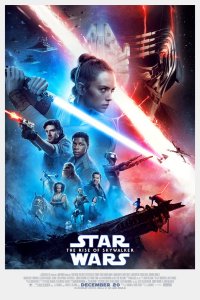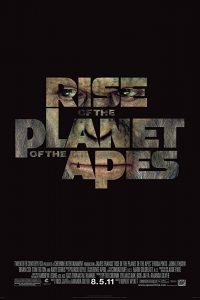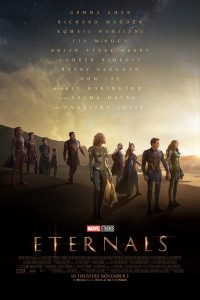Once More, Occasionally with Feeling: Gary Westfahl Reviews Star Wars: The Rise of Skywalker
 I have been obliged to extensively revise the original draft of this review, because after rereading what I had said about the previous two Star Wars films – J.J. Abrams’s Star Wars: The Force Awakens (2015 – review here) and Rian Johnson’s Star Wars: The Last Jedi (2017 – review here) – I found that on several occasions, I was saying the same thing I had said about one of the earlier films, sometimes employing nearly identical language. And that, perhaps, epitomizes everything that has gone wrong with this venerable franchise: for when filmmakers keep making the same film over and over again, reviewers will naturally be inclined to keep making the same observations over and over again.
I have been obliged to extensively revise the original draft of this review, because after rereading what I had said about the previous two Star Wars films – J.J. Abrams’s Star Wars: The Force Awakens (2015 – review here) and Rian Johnson’s Star Wars: The Last Jedi (2017 – review here) – I found that on several occasions, I was saying the same thing I had said about one of the earlier films, sometimes employing nearly identical language. And that, perhaps, epitomizes everything that has gone wrong with this venerable franchise: for when filmmakers keep making the same film over and over again, reviewers will naturally be inclined to keep making the same observations over and over again.
This does not mean, however, that I disliked Abrams’s Star Wars: The Rise of Skywalker, for I thoroughly enjoyed watching the film, and it passed the Westfahl Watch Test, as I was never inspired to look at my watch to see how much longer I would have to endure watching the film. If you go on an excellent amusement park ride, like Disneyland’s Haunted Mansion, you’re perfectly willing to return to it on multiple occasions, and no one can deny that the Star Wars films are a very good ride. On the other hand, if you go on the same ride several times in a short period of time, you will inevitably start to get bored. So if, as I have suggested, it is no longer possible to add anything genuinely new to a Star Wars film, it might be wise to periodically put the franchise on hold for a decade or more, as has twice occurred in the past. And although I scrupulously avoid reading any articles or reviews about films I am scheduled to review, simple glances at headlines on websites seem to indicate that Star Wars: The Rise of Skywalker is not receiving unanimously favorable reviews, and the overfamiliarity of all its features may be the reason.
Yet this film does have two special strengths. First, and quite appropriately, Abrams recognized that his task here was not only to complete the storyline of the previous two films, but also to provide a capstone to an entire series of nine Star Wars films that will be viewed by later generations as a unified epic, even as they are baffled by the varying quality of films that were created at varying times in varying circumstances. Thus, as best I can recall, virtually all of the major characters and alien races in the eight previous films either return to the screen or are referenced in some fashion, with the conspicuous exception of Jar-Jar Binks, whose absence will be lamented by no one.
I won’t discuss a few nods to earlier films that should properly come as a surprise, but I can talk about the reappearances that everyone already knows about, which for me represented the film’s emotional highlights. Brilliantly employing unused footage from Star Wars: The Force Awakens, Abrams has contrived to make the late Carrie Fisher’s General Leia a key figure in the film, and she is even given first billing in the credits, followed by another series veteran, Mark Hamill, who regularly materializes as the ghostly presence of Luke Skywalker. And surprisingly, I found it very satisfying to see Billy Dee Williams returning to the role of Lando Calrissian; while I never thought he quite fit in with the original cast in the second and third films, and while he didn’t seem to be missed in the last two films, his older and wiser Calrissian is far more evocative and impactful than he was in his original incarnation, contributing to the aura of gravitas provided by the other performers from previous films. (He’s also the character in this film who gets to intone the mandatory “I have a bad feeling about this.”) And I appreciated that the robot C-3PO, rather marginalized in the last two films, is finally provided with a more central role (though his companion R2-D2 remains overshadowed by the newer non-humanoid robot BB-8 and the even newer D-O).
The film’s second virtue involves the one way in which the Star Wars franchise provides a sharp and refreshing contrast to other contemporary action films. As I and others have noted before, these films’ typical heroes, facing enormous disasters threatening millions of people, are nevertheless solely obsessed with finding and protecting members of their own families. Nothing is more important, these films suggest, than maintaining bonds with one’s own family members. Yet the Star Wars films make the point that, sometimes, families actually represent something that people need to escape from, not to cling to. After all, it’s hard to defend prioritizing family values over everything else when your father is Darth Vader.
And one wonderful thing about the very first Star Wars film (1977) was the way that several disparate people, who had all lost (or lost touch with) their own families, came together to forge their own family, developing affection for one another and effectively blending their talents to achieve a well-deserved victory. (George Lucas rather spoiled things, in my view, when he subsequently revealed that two of those people were actually part of the same biological family.) And despite the family-centric approach of so many other films, the idea of breaking away from one’s family to construct another one may better resonate with numerous contemporary viewers who similarly no longer spend much time with their families but are sustained by their networks of friends. (One could relate this to the history of situation comedies, which in the 1950s almost always focused on close-knit families, but later more often dealt with groups of friends.)
One problem in the first two films was the need to provide the older characters with prominent roles, meaning that less attention was being paid to the evolving relationship of the major new characters: Rey (Daisy Ridley), Finn (John Boyega), and Poe Dameron (Oscar Isaac). In fact, they were frequently separated in order to accompany an older character. Here, except for Chewbacca (now played by Joonas Suotamo), the returning characters have very little screen time; the core group of Rey, Finn, Poe, and Chewbacca dominates the action and spends most of their time working together; and as a result, one gets the feeling that they have finally become the sort of ersatz family originally created by Luke Skywalker, Han Solo, Princess Leia, and Chewbacca. There is also one character who, like Skywalker and Leia, faces the need to break away from an unpleasant family.
Still, I think it is unfortunate that other potential members of this new family that struck me as appealing – the alien Maz Kanata (Lupita Nyong’o) from the first film, Rose Tico (Kelly Marie Tran) from the second film, and the newly introduced resistance fighter Jannah (Naomi Ackie) – mostly remain in the background. Noting that all of these characters are women, one might theorize that, facing complaints that recent Star Wars films have overemphasized female characters, Abrams decided that his core group must maintain a quota of only one woman.
While Star Wars: The Rise of Skywalker differs from some earlier films in its sense of closure and emphasis on irregular families, one must also talk about the ways that it is exactly the same as all the other films. The periodic action sequences, I believe, are becoming more tedious than exciting. There are only so many ways to show spaceships soaring through narrow corridors while blasting away at pursuing adversaries, duels to the death between adversaries wielding lightsabers, and a final confrontation between vast arrays of evil enemies with powerful weapons and a small group of beleaguered rebels with a desperately improvised plan to defeat them. And at this point in the history of the franchise, virtually every possible variation on these set pieces has been executed. Bluntly, the only novelty this film can boast of is flying stormtroopers, which simply means their battles can now resemble the previous battles involving spaceships.
Furthermore, the typical quiet moments in these films can become monotonous as well; for example, the succession of inconclusive meetings between Rey and Kylo Ren all start to blur together, even if they all offer one new fact about Rey and her background. And, films with the same sorts of stories will be compelled to keep offering the same sorts of messages, all repeated here – about the need to fight the good fight, to persevere against all odds, to believe in yourself no matter what, yadda yadda yadda. Surely, only someone who has never seen a Star Wars film could possibly find the umpteenth iterations of such bromides truly inspiring. Yet Abrams seems so fond of his trite aphorisms that he uses a few of them twice, spoken by different characters.
There are also a number of recurring plot devices in Star Wars films that grow tiresome, especially for anyone devoted to genuine science fiction; one does not need to check the credits of these films to see that they never include a Science Advisor. I was strangely reminded of Hugo Gernsback’s arch editorial comments on John W. Campbell, Jr.’s 1932 story “Space Rays”, complaining that the story reflected “a policy of what I might call scientific magic, in other words, science that is neither plausible, nor possible. Indeed, it overlaps the fairy tale, and often goes the fairy tale one better …. [Campbell] pulls, magician-like, all sorts of impossible rays from his silk hat, much as a magician extracts rabbits….” Two different sorts of “scientific magic” are ubiquitous in the world of Star Wars: first, whenever there is any problem with a mechanical device, a robot extends a tiny arm, inserts it into the device, and immediately fixes the problem. Second, people who are especially attuned to the Force, like Skywalker and Rey, can do virtually anything they have to do, as long as they furrow their brows and concentrate.
In one odd way, Abrams appears to acknowledge that, in most respects, he is retelling a very old story. From the start, Lucas wanted Star Wars to display a “used future”: machines would not be shiny and new, as in so many other science fiction films, but would look like they had been built long ago and had suffered some wear and tear. At several times in this film, characters encounter what can only be described as an ancient future; they venture into long-abandoned ruins, pick up dusty artifacts, discover skeletons, and try to interpret writings from the distant past. Quite literally, they are following in the footsteps of countless generations of predecessors – and one could say the same about anyone undertaking to make yet another Star Wars film.
The theme of harkening back to the past manifests itself in other ways. Significantly, all characters in the film are seeking to restore old institutions: the revived Emperor Palpatine (Ian McDiarmid) and his minions want to reestablish the evil Empire, while the rebels want to bring back the Galactic Republic and revive the Jedi tradition. None of the rebels, it seems, ever build a new spaceship; instead, they are constantly rediscovering and repairing old spaceships. And Kylo Ren announces that he “can’t go back” to where he was before, on the Light Side; but as everyone has known since the character made his first appearance, he can, and eventually does.
In the end, even if it does not arouse enormous enthusiasm, Star Wars: The Rise of Skywalker will undoubtedly earn enough money to justify further investments in the franchise; yet I cannot discern how Disney executives can indefinitely earn huge profits from making the same film every two years. They have, I think, two options. First, they can boldly move in some radical new direction; for example, they could seek to establish some sort of connection between the Star Wars galaxy and our own world, perhaps by describing some of its residents embarking upon a long journey to faraway galaxies that eventually brings them to Earth and forces them to confront the ambiguities of our reality in contrast to the simplistic melodrama of their current lives. Or they could explore the distant past or distant future of the Star Wars universe, necessarily demanding the creation of new sorts of technology and new sorts of story lines. Second, they can instead opt to cautiously stick to Lucas’s tried-and-true formulas, but in that case, they should (as indicated above) make films far less frequently, so that audiences don’t grow tired of them. Or they could stop making films altogether and focus on earning income from more and more Star Wars video games and amusement park rides – since that is essentially the sort of entertainment that the franchise has always provided.
Directed by J.J. Abrams
Written by Chris Terrio and J.J. Abrams, based on a story by J.J. Abrams, Chris Terrio, Derek Connolly, and Colin Trevorrow, based on characters created by George Lucas
Starring Carrie Fisher, Mark Hamill, Adam Driver, Daisy Ridley, Oscar Isaac, John Boyega, Oscar Isaac, Anthony Daniels, Naomi Ackie, Ian McDiarmid, Billy Dee Williams, Domhnall Gleeson, Richard E. Grant, Lupita Nyong’o, Keri Russell, Joonas Suotamo, Kelly Marie Tran, Greg Grunberg, and Shirley Henderson
Gary Westfahl, Professor Emeritus at the University of La Verne, has published 27 books about science fiction and fantasy, including the Hugo Award-nominated Science Fiction Quotations: From the Inner Mind to the Outer Limits (2005), The Spacesuit Film: A History, 1918-1969 (2012), and A Sense-of-Wonderful Century: Explorations of Science Fiction and Fantasy Films (2012); excerpts from these and his other books are available at his World of Westfahl website. He has also published hundreds of articles, reviews, and contributions to reference books. His next two books, to be published in 2019, are the co-edited Science Fiction and the Dismal Science: Essays on Economics in and of the Genre and the critical study The Rise and Fall of American Science Fiction, 1920s to 1960s.
©Locus Magazine. Copyrighted material may not be republished without permission of LSFF.








Gary, you are so right, there are many distractions woven into this film. I look forward to seeing it again. That should make the Disney execs happy–don’t you think 😉
How about this….. Disney… do some science fiction that is different!
There is a ton of prose science fiction that served as the source for all the world building in Star Wars… (by the by SF , on the page, also served up the materials for world building in Star Trek too.)
Star Wars is Flash Gordon…. rejiggered … well, a whole make over… even things like Asimov’s Galactic Empire borrowed from Foundation (Lucas interview in Rolling Stone in 1976) … and so forth…
How about Have Space Suit Will Travel by Heinlein ? I would not turn it into a series tho.
Or one could take the Heinlein YA novels and make them into a series lots of great stories there which would only need a small about of updating and some imaginative melding.
Poul Anderson’s Technic series , this would sophisticated space opera several steeps beyond Star Trek… in intelligent and imaginative hands it would be adult far future space opera like no one has ever seen.*
James Blish’s Cities in Flight would be some SF that has never been done.
Disney has done movies for the 15 years old and up crowd , The Stars My Destination, done correctly, could be sensational.
Even Andrea Norton , with some fix up could be good.
Go Crazy! Do the Instrumentality of Cordwainer Smith , no one, but no one , has done any movie SF like that!
Give the Star Wars universe a rest!
*Note , classic 200 years in the future SF is being done right now on TV with The Expanse.